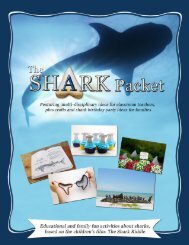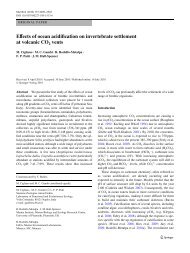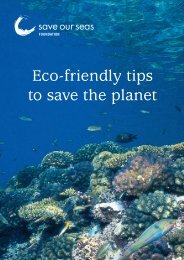South Africa's White Shark cage-diving industry - Save Our Seas ...
South Africa's White Shark cage-diving industry - Save Our Seas ...
South Africa's White Shark cage-diving industry - Save Our Seas ...
Create successful ePaper yourself
Turn your PDF publications into a flip-book with our unique Google optimized e-Paper software.
<strong>South</strong> Africa’s <strong>White</strong> <strong>Shark</strong> <strong>cage</strong>-<strong>diving</strong> <strong>industry</strong> -<br />
is their cause for concern?<br />
The sensory stimulus that entices the white shark to the '<strong>cage</strong> <strong>diving</strong> vessel' are initially<br />
'smell' and later, when specifically identifying the locality of potential food, it is 'vision' and<br />
‘smell’ (previously discussed). Thus similarity in 'olfactory' and 'visual' stimulation is required<br />
for a conditioned shark to associate a new object with a <strong>cage</strong> <strong>diving</strong> vessel and have its<br />
anticipated feeding response evoked. We have examined the various human activities<br />
(commercial and recreational fishing vessels, recreational non fishing vessels, kayaking,<br />
board riding, swimming, scuba <strong>diving</strong>, spear fishing) and calculated the likelihood that they<br />
will elicit such a 'conditioned response'. Visual similarity was rated (from 0 = dissimilar, up to<br />
4 = identical) in terms of size, shape, and behaviour (e.g. bottom vs. surface, anchor vs.<br />
floating), olfactory was rated similarly in terms of odour similarity and strength (Fig. 10).<br />
Resulting scores were used to score (0-19% = highly improbable, 20-39% = improbable; 40-<br />
59% = possible, 60-79% = probable, 80-99% highly probable) then rank the various activities<br />
(Fig. 10). It must, however, be stressed, that whilst we used other animal studies to<br />
approximate perceived similarity, these ratings represent educated guesses only. From this<br />
investigation, it appears highly improbable that a sharks 'conditioned reflex' would be<br />
stimulated if it fortuitously encountered either swimmers, surfers, kayakers, scuba divers, or<br />
spear fishermen due to visual and olfactory dissimilarity from a <strong>cage</strong> <strong>diving</strong> vessel (Fig. 10).<br />
Therefore, it is highly unlikely that <strong>cage</strong> <strong>diving</strong> is related to attacks on humans. It is however,<br />
probable that commercial and recreational fishing vessels could be mistaken as <strong>cage</strong> <strong>diving</strong><br />
vessels and a conditioned response may be evoked (Fig. 10). However, it must be<br />
remembered that these vessels are essentially simulating chumming vessels in many ways.<br />
6. Management of the <strong>cage</strong> <strong>diving</strong> <strong>industry</strong><br />
The Department of Environmental Affairs and Tourism (DEAT) is tasked with the<br />
management of the <strong>cage</strong> <strong>diving</strong> <strong>industry</strong> in <strong>South</strong> Africa. As such, total allowable effort, the<br />
operational procedure, and the industries compliance all fall under DEAT's mandate. As such<br />
it is worthwhile assessing this aspect of the <strong>cage</strong>-<strong>diving</strong> <strong>industry</strong> in relation to ensuring no<br />
sharks become conditioned.<br />
The Marine Living Resources Act (MLRA) was ratified in 1998 (Act No. 18, 1998) seven<br />
years after vessels in <strong>South</strong> Africa began to attract white sharks for tourism and viewing<br />
purposes. When applying the act to the existing <strong>industry</strong> several considerations had to be<br />
assessed. These included the development of international tourism, socio-economic<br />
considerations, the optimal sustainable utilisation of <strong>South</strong> <strong>Africa's</strong> marine resources, and the<br />
precautionary principle. As such, it was decided that the existing <strong>industry</strong> fulfilled the MLRA's<br />
mandate with regards to the non-consumptive exploitation of the protected white shark.<br />
Critics of the <strong>industry</strong>, however, rightly point out that in addition to 'optimal utilisation' the<br />
MLRA also stipulates the need to apply a precautionary approach in respect of the<br />
management and development of marine living resources.<br />
Pg 53<br />
ANNEXURE 1






